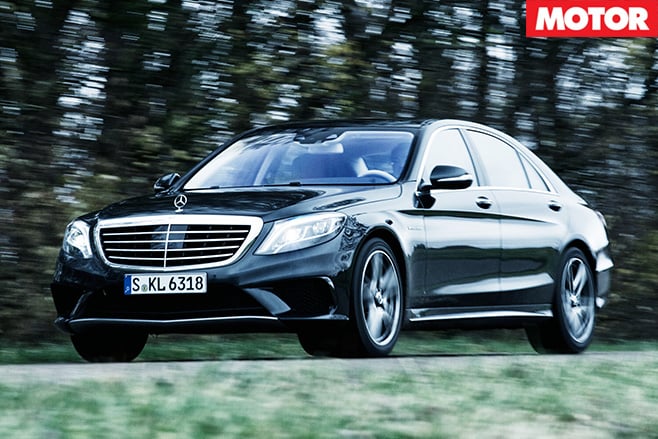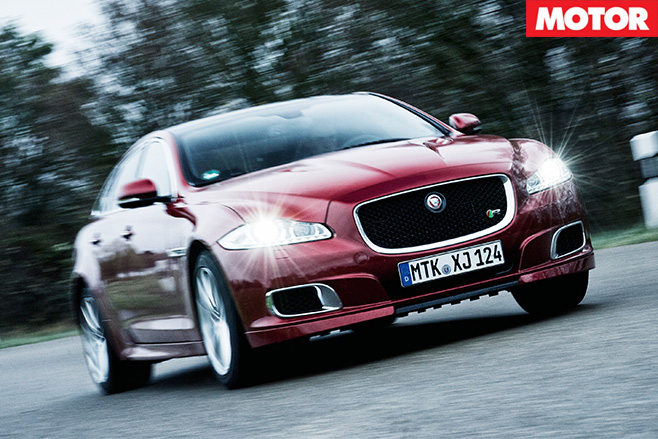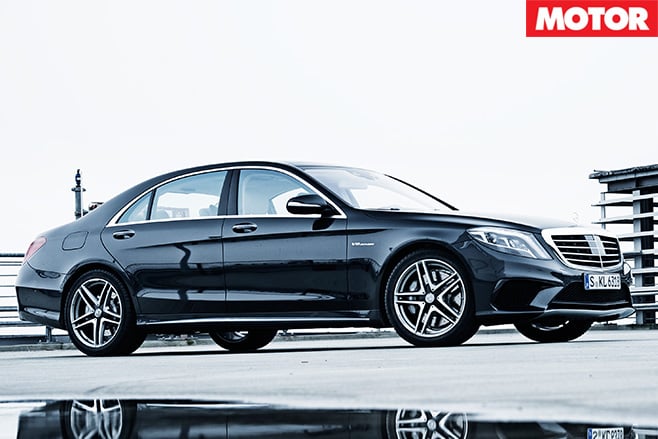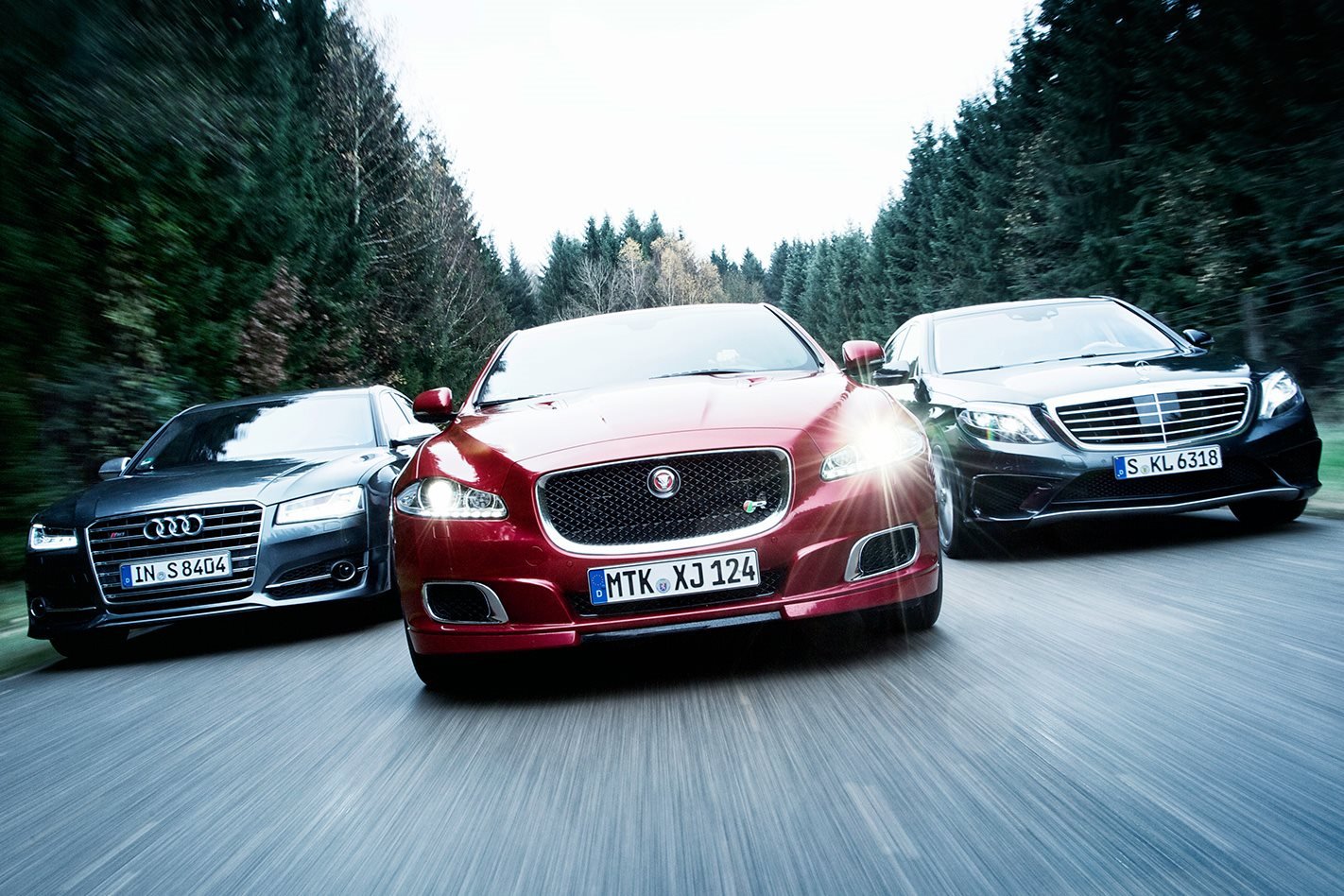The essence of white-knuckle driving pleasure is composed of howling V8s, flickering stability control lights and a lust factor that grows in proportion with speed.
Which is why this trio has absolutely no ambition to stitch up the hole in the ozone layer. Quite the contrary. In 72 hours, we navigated the breathtaking roads of rural Upper Bavaria, Salzburg and Tyrol where we could drive the rubber socks off these three high-performance five-seat flagships – the Audi S8, the Jaguar XJR and the Mercedes-Benz S63 AMG 4MATIC long-wheelbase – in a remote, radar-free environment.
If cost had been the decider, this comparison would have ended before it began. Both the XJR and S63 are the current flagships in each car’s model range, which penalises them with a hefty premium over less-endowed variants whereas Ingolstadt decided to position the A8L W12 as its flagship model, shortening the S8’s price.
Expected to land in Australia at around $270,000, it will undercut the regular Mercedes S63 AMG (long-wheelbase isn’t planned for Australia, nor is the 4MATIC all-wheel drive system) by about $100K, and be around $30K cheaper than Jaguar’s XJR.
But the Mercedes also gives you the most for your money. Grunt wise, the 430kW/900Nm S-Class easily eclipses the 405kW/680Nm Jaguar and 382kW/650Nm Audi. Its 5.5-litre twin-turbo V8 engine runs quietly and smoothly, throttle response (even in sport mode) is relatively restrained and relaxed, and the seven-speed transmission surfs the immense wave of torque in a subtle manner.

The Audi S8, too, benefits from the grip and traction only four-wheel drive can muster, losing only one tenth to the more powerful but heavier Mercedes to 100km/h. As speeds climb, the smaller 4.0-litre twin-turbo V8 fails to match the Mercedes’ acceleration, but it does manage to slurp 10-15 per cent less fuel than the other two, an on-test 13.4L/100km beating the Benz’s 16.0L/100km and Jaguar’s 15.0L/100km.

The XJR’s interior ambience is one of modern charm, with cabin accents of polished timber and glossy metal offset with wall-to-wall leather and alcantara and all the usual mod-cons paired with a decent sound system. However, the Brit doesn’t include as much high-tech gadgetry as its challengers from across the pond. Even essentials such as tyre pressure monitoring, adaptive cruise control and blind-spot monitoring cost extra.

Even though the S8’s interior scores a few points for the best fit and finish, classiest instruments, most tasteful interior and brightest LED headlights, not everything’s perfect. The MMI entertainment system is getting more complex with every round of modifications, access to the extensive Drive Select menu should be more intuitive, and the gear selector often needs two or three attempts to engage and stay in reverse. Further marking it down is the fact that the long-wheelbase version is not available in most markets, so tall back-seat passengers will struggle for space.

In contrast to the charming Jag and the business-like Audi, the Mercedes has received the full go-faster treatment as ordered by the marketing department.
The rubber-studded pedals are milled from solid aluminium; the seats boast bespoke leather, stitching, piping and emblems; the stylish body kit should be as good at reducing drag as it is turning heads; the four tailpipes are almost as wide as wombat holes; and to avoid confusion with lesser Benzes there are about two dozen AMG logos scattered throughout the car.

But it’s when you put the car to the test by waltzing through a set of curves that a larger-than-expected portion of the promised dynamic sparkle is lost in translation. The driver is constantly tailed by a battalion of electronic helpers assisting in changing lanes, keeping a safe distance, braking in an emergency, pulling at the steering wheel, or parking the car automatically.

The Jaguar specialises in the very British art of refined part-throttle cruising, but flex your right foot and the XJR will instantly change down a gear or two and charge at the horizon with the explosive energy of Usain Bolt. But then if you decide you want manic from one moment to the next, bury the loud pedal and hold on.

In sport, it feels more like dual-clutch transmission than an auto, holding on to a given ratio all the way to the redline, then shifting with time-warp efficiency. The brakes bite with unyielding force and roll-on acceleration punches you hard in the guts.
As for the S8, its driving dynamics should be spot-on, and yet in real life they form an odd mix of highs and lows.
Take the handling, which ranges from defensive to indifferent. The steering refuses to feed your palms with enough weight, self-centring action or grip information while the brakes, which are very powerful and totally immune to fade, could do with a more progressive pedal action. Try the air suspension in all three available settings, and you will wonder why not even comfort mode provides a satisfactory level of compliance for a car asking this much.

On the other hand, the Benz has got what it takes to be the best of all worlds, and yet isn’t. It’s a complete and competent car, but its visual appeal is not enhanced by all those nip ’n’ tuck modifications. And it feels like its true dynamic potential has been smothered by many layers of cotton wool and nanny tech.
Instead, you buy a tonne of kit and a 0.8sec 0-100km/h acceleration advantage over a cheaper priced in-house alternative like the S550. The S63 just feels like a fast S-Class, and not enough like the raw driving machine its baby brother E63 AMG is, lacking the same effect on your adrenal glands as most other AMG products.

It reaches its limit earlier than expected and when it does the XJR finds it more difficult to maintain its balance and hold the road than the S8 or S63 AMG. All of which is another way of saying that the Jaguar is competent and controversial, but flawed in a charming way.
The most accurate conclusion is: in terms of their intended purpose, combining autobahn-slaying speed with ultimate luxury and driver enjoyment, they all fall short.

Instead, they illuminate the more conservative offerings in respective model ranges as probably a better place to spend some cash and picking one, if you must, comes down to your personal taste.
The Audi will appeal to those who like to fly under the radar, the Mercedes to the power junkie, and the Jaguar to the executive that likes to indulge in a bit of drifting between board meetings.
| u00a0 | u00a0 | u00a0 | u00a0 | u00a0 | u00a0 | 4/5 | u00a0 | u00a0 | u00a0 | u00a0 | u00a0 | 3.5/5 | u00a0 | u00a0 | u00a0 | u00a0 | u00a0 | 3.5/5 |
| u00a0 | u00a0 | u00a0 | u00a0 | u00a0 | u00a0 | Mercedes S63 AMG | u00a0 | u00a0 | u00a0 | u00a0 | u00a0 | Jaguar XJR | u00a0 | u00a0 | u00a0 | u00a0 | u00a0 | Audi S8 |
| Body | u00a0 | u00a0 | u00a0 | u00a0 | u00a0 | 4 door, 5-seat sedan | u00a0 | u00a0 | u00a0 | u00a0 | u00a0 | 4 door, 5-seat sedan | u00a0 | u00a0 | u00a0 | u00a0 | u00a0 | 4 door, 5-seat sedan |
| Drive | u00a0 | u00a0 | u00a0 | u00a0 | u00a0 | all wheel drive | u00a0 | u00a0 | u00a0 | u00a0 | u00a0 | rear wheel drive | u00a0 | u00a0 | u00a0 | u00a0 | u00a0 | all wheel drive |
| Engine | u00a0 | u00a0 | u00a0 | u00a0 | u00a0 | 5461cc V8, DOHC,u00a0 32v, twin-turbo | u00a0 | u00a0 | u00a0 | u00a0 | u00a0 | 5000cc V8, DOHC, 32v, supercharged | u00a0 | u00a0 | u00a0 | u00a0 | u00a0 | 3993cc V8, DOHC, 32v, twin-turbo |
| Bore/Stroke | u00a0 | u00a0 | u00a0 | u00a0 | u00a0 | 98 x 90.5mm | u00a0 | u00a0 | u00a0 | u00a0 | u00a0 | 92.5 x 93mm | u00a0 | u00a0 | u00a0 | u00a0 | u00a0 | 84.5 x 89mm |
| Compression | u00a0 | u00a0 | u00a0 | u00a0 | u00a0 | 10:1 | u00a0 | u00a0 | u00a0 | u00a0 | u00a0 | 9.5:1 | u00a0 | u00a0 | u00a0 | u00a0 | u00a0 | 9.3:1 |
| Power | u00a0 | u00a0 | u00a0 | u00a0 | u00a0 | 430kW @ 5550rpm | u00a0 | u00a0 | u00a0 | u00a0 | u00a0 | 405kW @ 6500rpm | u00a0 | u00a0 | u00a0 | u00a0 | u00a0 | 382kW @ 6000rpm |
| Torque | u00a0 | u00a0 | u00a0 | u00a0 | u00a0 | 900Nm @ 2250-3750rpm | u00a0 | u00a0 | u00a0 | u00a0 | u00a0 | 680Nm @ 2500-5500rpm | u00a0 | u00a0 | u00a0 | u00a0 | u00a0 | 650Nm @ 1700-5500rpm |
| Power/Weight | u00a0 | u00a0 | u00a0 | u00a0 | u00a0 | u00a0207kW/tonne | u00a0 | u00a0 | u00a0 | u00a0 | u00a0 | 216kW/tonneu00a0 | u00a0 | u00a0 | u00a0 | u00a0 | u00a0 | 192kW/tonneu00a0 |
| 0-100km/h | u00a0 | u00a0 | u00a0 | u00a0 | u00a0 | 4.0sec(claimed) | u00a0 | u00a0 | u00a0 | u00a0 | u00a0 | 4.6sec(claimed) | u00a0 | u00a0 | u00a0 | u00a0 | u00a0 | 4.1sec(claimed) |
| Top Speed | u00a0 | u00a0 | u00a0 | u00a0 | u00a0 | 300km/h(limited) | u00a0 | u00a0 | u00a0 | u00a0 | u00a0 | 280km/h(limited)u00a0 | u00a0 | u00a0 | u00a0 | u00a0 | u00a0 | 250km/h(limited)u00a0 |
| Consumption | u00a0 | u00a0 | u00a0 | u00a0 | u00a0 | 15.0L/100km | u00a0 | u00a0 | u00a0 | u00a0 | u00a0 | 16.0L/100kmu00a0 | u00a0 | u00a0 | u00a0 | u00a0 | u00a0 | 13.6L/100kmu00a0 |
| Emissions | u00a0 | u00a0 | u00a0 | u00a0 | u00a0 | 357g/km CO2 | u00a0 | u00a0 | u00a0 | u00a0 | u00a0 | 381g/km CO2u00a0 | u00a0 | u00a0 | u00a0 | u00a0 | u00a0 | 327g/100km CO2u00a0 |
| Transmission | u00a0 | u00a0 | u00a0 | u00a0 | u00a0 | 7-speed automatic | u00a0 | u00a0 | u00a0 | u00a0 | u00a0 | 8-speed automatic | u00a0 | u00a0 | u00a0 | u00a0 | u00a0 | 8-speed automatic |
| Weight | u00a0 | u00a0 | u00a0 | u00a0 | u00a0 | 1995kg | u00a0 | u00a0 | u00a0 | u00a0 | u00a0 | 1881kg | u00a0 | u00a0 | u00a0 | u00a0 | u00a0 | 1915kg |
| Suspension | u00a0 | u00a0 | u00a0 | u00a0 | u00a0 | multi-links, air springs, tubular torsion bar(f); multi-links, air springs, torsion bar(f); | u00a0 | u00a0 | u00a0 | u00a0 | u00a0 | double A arms, coil springs, anti roll bar(f);u00a0multi-links, coil springs, anti roll bar(r)u00a0 | u00a0 | u00a0 | u00a0 | u00a0 | u00a0 | double A arms, air dampers, anti-roll bar(f); mutli links, air dampers, anti-roll bar(r) |
| L/W/H | u00a0 | u00a0 | u00a0 | u00a0 | u00a0 | 5287/1915/1499mm | u00a0 | u00a0 | u00a0 | u00a0 | u00a0 | 5252/2105/1457mm | u00a0 | u00a0 | u00a0 | u00a0 | u00a0 | 1990/1949/1458mmu00a0 |
| Wheelbase | u00a0 | u00a0 | u00a0 | u00a0 | u00a0 | 3165mmu00a0 | u00a0 | u00a0 | u00a0 | u00a0 | u00a0 | 3157mmu00a0 | u00a0 | u00a0 | u00a0 | u00a0 | u00a0 | 2994mm |
| Tracks | u00a0 | u00a0 | u00a0 | u00a0 | u00a0 | 1624/1637mm(f/r)u00a0 | u00a0 | u00a0 | u00a0 | u00a0 | u00a0 | 1626/1604mm(f/r) | u00a0 | u00a0 | u00a0 | u00a0 | u00a0 | 1632/1623mm(f/r)u00a0 |
| Steering | u00a0 | u00a0 | u00a0 | u00a0 | u00a0 | electrically-assisted rack and pinionu00a0 | u00a0 | u00a0 | u00a0 | u00a0 | u00a0 | hydraulically assisted rack pinion | u00a0 | u00a0 | u00a0 | u00a0 | u00a0 | electrically-assisted rack and pinionu00a0 |
| Brakes | u00a0 | u00a0 | u00a0 | u00a0 | u00a0 | 390mm discs; ventialted discs; fixed calipers(f); 360mmu00a0ventialted discs; fixed calipers(r); | u00a0 | u00a0 | u00a0 | u00a0 | u00a0 | 380mm discs; four piston calipers (f); 376mmu00a0ventialted discs; single piston calipers(r); | u00a0 | u00a0 | u00a0 | u00a0 | u00a0 | 399mm discs; six piston calipers (f); 356mmu00a0ventialted discs; piston calipers(r); |
| Wheels | u00a0 | u00a0 | u00a0 | u00a0 | u00a0 | 19 x 8.5 inch(f); 19 x 9.5 inch (r) | u00a0 | u00a0 | u00a0 | u00a0 | u00a0 | 20u00a0x 8.5 inch(f); 20 x 9.5 inch (r) | u00a0 | u00a0 | u00a0 | u00a0 | u00a0 | 20 x 9.0 inch(f/r) |
| Tyres | u00a0 | u00a0 | u00a0 | u00a0 | u00a0 | 255/40 R20(f); 285/35 R20(r) | u00a0 | u00a0 | u00a0 | u00a0 | u00a0 | 245/45 R19(f); 275/40 R19(r) | u00a0 | u00a0 | u00a0 | u00a0 | u00a0 | 265/40 R20 104Y(f/r) |
| Price | u00a0 | u00a0 | u00a0 | u00a0 | u00a0 | $385,000(Aust. SWB) | u00a0 | u00a0 | u00a0 | u00a0 | u00a0 | $298,000(Aust. SWB) | u00a0 | u00a0 | u00a0 | u00a0 | u00a0 | $270,000(TBC) |
| Positives | u00a0 | u00a0 | u00a0 | u00a0 | u00a0 | Incredibly fast, more technology than NASA; sumptuos interior | u00a0 | u00a0 | u00a0 | u00a0 | u00a0 | Hooligan nature;fantastic engine; distinctive looks | u00a0 | u00a0 | u00a0 | u00a0 | u00a0 | Interior qulaity; fuel economy; bags of grip; (relative) value |
| Negatives | u00a0 | u00a0 | u00a0 | u00a0 | u00a0 | Huge money; nannying electronic systems; no 4MATIC for Ozu00a0 | u00a0 | u00a0 | u00a0 | u00a0 | u00a0 | Unrefined transmission;traction issues; lacks the German’s techu00a0 | u00a0 | u00a0 | u00a0 | u00a0 | u00a0 | Remote driving experience; looks dull; average ride |





